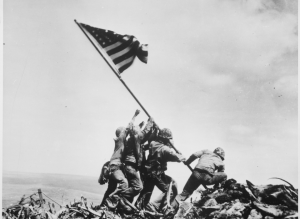Chapter 2: Origins and Evolution of PR
Before there were televisions, radios, newspapers, printing presses, or even woodblock printing, there was public relations. The craft dates back in a documentable way to at least ancient Greece, as Athenian scholars and aristocrats (notably Plato, Aristotle, and Socrates) contemplated the effective use of rhetoric in the public sphere and the realm of governance.
In some way, shape, or form, leaders in government, religion, and society have employed PR practices for thousands of years, whether that was by giving out free bread at the Coliseum to poorer Roman citizens or the creation of state-sponsored entertainment and propaganda inside the Coliseum itself. Julius Caesar wrote an autobiographical account of his military success in an effort to persuade influential Romans that he would be best suited to preside over the growing empire.
The introduction of the printing press spurred new opportunities for more affordable mass communication, which is a common theme in public relations: as new technologies are introduced, they are used for PR purposes. Major innovations in communications and transportation technology inevitably resulted in their increased use by opinion leaders to engage their audiences.
Major political movements of the 18th and 19th century were the subject of and beneficiary of new technologies and public relations techniques. Noteworthy examples include the dissemination of communist ideals, as penned by Karl Marx, and the justification for the American Revolution, which was heavily advanced through pamphlets, newspapers, and speeches.
Important precursors to the modern era of PR can be found in 19th century world of publicists who specialized in promoting circuses, theatrical performances, and other public spectacles. Of circus fame, the oft-quoted P.T. Barnum is known for his use of publicity tactics—or press agentry—to generate attention for his shows and attractions. He was famous for coining the phrase, “There’s no such thing as bad publicity” (Grunig & Hunt, 1984, p. 28). He was even known to pen letters to the editor under a fake name, outing some of his attractions as hoaxes just to generate publicity and keep news coverage going. Unfortunately, Barnum’s ethics left much to be desired.
20th Century Evolution of PR
In the United States, where professionalized public relations has its origins, many early PR practices were developed in support of the expansive power of the railroads. In fact, the first documented use of the term “public relations” appeared in the 1897 Year Book of Railway Literature and the first press release written was sent by Ivy Lee on behalf of the Pennsylvania Railroad following a terrible train derailment.
Later, public relations practitioners were—and are still often—recruited from the ranks of journalists. Some journalists, concerned with ethics, have criticized former colleagues for using their inside understanding of news media to help clients receive favorable news coverage (Caywood, 1997).
The First World War also helped stimulate the development of public relations as a profession. Many of the first public relations professionals—including Edward L. Bernays and Carl Byoir—worked with the Committee on Public Information (also known as the “Creel Commission”), which organized publicity on behalf of American objectives during World War I. Some historians regard Ivy Lee as the first real practitioner of public relations, but Bernays is generally regarded today as the profession’s founder. In describing the origin of the term “public relations,” Bernays commented:
When I came back to the United States, I decided that if you could use propaganda for war, you could certainly use it for peace. And propaganda got to be a bad word because of the Germans using it. So what I did was to try to find some other words, so we found the words Council on Public Relations. (Curtis, 2022)
Lee, who has been credited with developing the modern “news release” (previously known as a “press release” and sometimes now called a “media release”), espoused a philosophy consistent with what has sometimes been called the “two-way street” approach to public relations, in which public relations consists of helping clients listen, as well as communicate messages to their publics.
Bernays was the profession’s first theorist. A nephew of Sigmund Freud, Bernays drew many of his ideas from Freud’s theories about the irrational, unconscious motives that shape human behaviour. One of Bernays’ early clients was the tobacco industry. In 1929, he orchestrated a legendary publicity stunt aimed at persuading women to take up cigarette smoking, which was then considered unfeminine and inappropriate for women with any social standing. Bernays arranged for New York City débutantes to march in that year’s Easter Day Parade, defiantly smoking cigarettes as a statement of rebellion against the norms of a male-dominated society.
Following the stock market crash of 1929, the National Association of Manufacturers became the first lobby group to have its own in-house public relations department, with the goal of improving American attitudes towards businesses during the Great Depression (The Public Relations Museum, n.d.).

Wartime propaganda, always popular among governments, both democratic and

authoritarian, made major advancements in the 1930s, especially in Germany, where political manifestos, patriotic imagery, and aspirational films (notably Triumph of the Will) motivated impassioned loyalty to the Nazi regime of the day. Once World War II began, Allied propaganda also increased, such as with the use of “Rosie the Riveter” posters to motivate women to join the industrial workforce. Equally, the image of US Marines raising the flag on Mt. Suribachi was used to inspire Americans to continue supporting the war effort.
Following the war, there was an explosion in the number of public relations firms, especially in New York City. The practice was quickly linked to parallel growth in marketing and advertising firms. These firms often worked with political entities, as well, contributing to the increasing sophistication of election campaigns.
In 1950, PRSA enacted the “Professional Standards for the Practice of Public Relations,” a forerunner to the current Code of Ethics, revised in 2000, to include six core values and six Code provisions. These six core values are “Advocacy, Honesty, Expertise, Independence, Loyalty, and Fairness” (Public Relations Society of America, n.d.). The six Code provisions are “Free Flow of Information, Competition, Disclosure of Information, Safeguarding Confidences, Conflicts of Interest, and Enhancing the Profession” (n.d.).
As the century progressed, an increasing majority of people in western countries had televisions in their home and, much later, internet access (though this did not become a majority of the population until the early 21st century). The population was increasingly enrolling in post-secondary education and awareness of the public sphere reached an all-time high.
In 1982, the rise of crisis communications as a quintessential part of public relations emerged, as Tylenol navigated a crisis precipitated by a murderer lacing their product with cyanide, killing seven people (Public Relations Museum, n.d.). The response to this crisis changed how medicine is packaged and saw the advent of the “1-800” number hotline.
The practice—and the number of practitioners—has been steadily growing globally, especially as public investment in journalism fades and as closed societies, such as those in the former Soviet Union, become more open and commercial. Modern public relations uses a variety of techniques, including opinion polling and focus groups, to evaluate public opinion. This is combined with a variety of high-tech techniques for distributing information on behalf of their clients, including satellite feeds, the internet, email blasts, and database-driven phone banks to advance a client’s cause.
As the internet became a more entrenched part of daily life in Western society, and as mobile phones and social media also became normative, political rock star Barack Obama, coupled with experts and insiders from Silicon Valley, put a budget of over $700 million behind his 2008 election campaign, creating a unique synthesis of public relations, technology, and real-world action that saw him sweep into office as the 44th President of the United States.
Also in 2008, China hosted the Olympic Games in Beijing, with a state-sponsored and highly orchestrated publicity event designed to implicitly announce to the world that the People’s Republic of China would challenge America as the dominant global state power.
The significance of 2008 as a turning point in world politics and public relations cannot be overstated and, for the purposes of studying public relations, 2008 represents the conclusion to this prologue of contemporary PR practice.
References
Caywood, C. (1997). The handbook of strategic public relations & integrated communications. McGraw Hill.
Curtis, A. (Writer & Director). (2002). The century of the self. BBC.
Grunig, J. & Hunt, T. (1984). Managing public relations. Wadsworth.
National WWII Museum. (n.d.). Iwo Jima and Okinawa: Death at Japan’s doorstep. https://www.nationalww2museum.org/war/articles/iwo-jima-and-okinawa-death-japans-doorstep
Public Relations Museum. (n.d.). Public relations through the ages: A timeline of social movements, technology milestones and the rise of the profession. https://www.prmuseum.org/pr-timeline
Public Relations Society of America. (n.d.). PRSA code of ethics. https://www.prsa.org/about/ethics/prsa-code-of-ethics
Attributions
Parts of this chapter were adapted from Public Relations, published by Andy Schmitz in the 2012 Book Archive, which is licensed under a Creative Commons Attribution-NonCommercial-ShareAlike 3.0 International License.
Parts of this chapter were adapted from Public Relations, by New World Encyclopedia, which is licensed under a Creative Commons Attribution-ShareAlike 3.0 International License.

